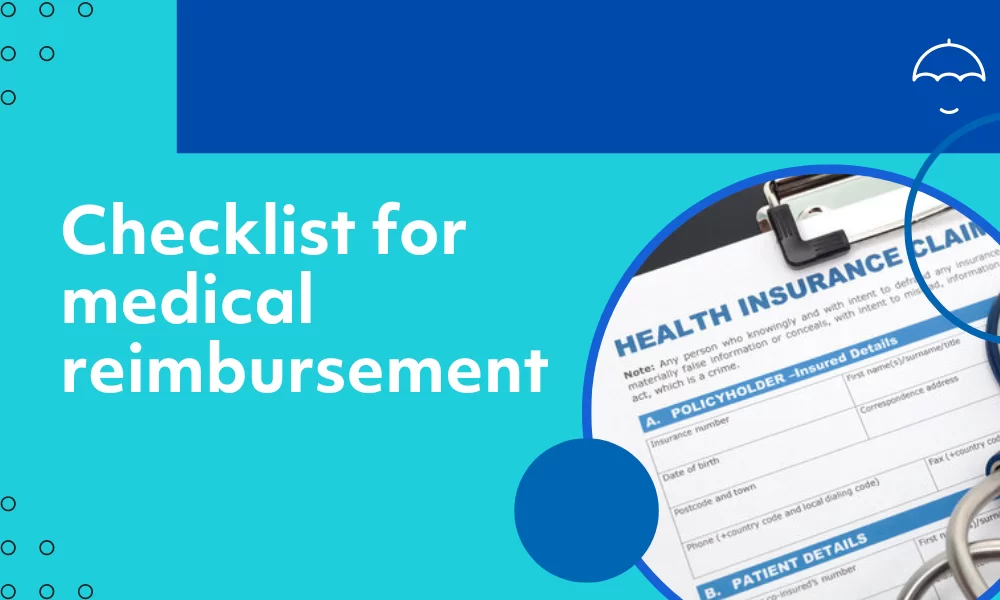Checklist for Medical Reimbursement
Each medical insurance service provider has their own reimbursement form that you need to fill and attach all the required documents to ensure you get the claim reimbursed.
Usually there are two parts of the claims reimbursement form –
- Part A
This part is meant for you as the insured person, to fill in your contact details, and other information about your insurance, hospitalization, and other particulars.
- Part B
This part is meant for the hospital in which you or any of your family members was admitted. The hospital will fill in all the details about the person’s hospitalization like – date, treatment details, cost etc.
Documents Required for Health insurance Reimbursement
This is the list of documents that you should keep handy to fill in the claim of your health insurance policy –
- Original claim form duly completed with your signature
- Valid identity proof
- FIR (if required)
- Doctor’s prescription advising tests, medications etc.
- Doctor’s prescription suggesting admission to hospital
- Original pharmacy bills
- Ambulance bills
- Policy details including – policy number, name of insured, address, and disease for which treatment is going on
Checklist for health insurance reimbursement
Filling in the reimbursement form can be quite a cumbersome task especially if you are doing it for the first time. Here’s a step-by-step guide for you to fill in the form –
Step 1 – fill out details of the primary insured
Fill out all the details about the primary insured like – name, complete address with pin code, policy number, and other personal details. Keep in mind that if the policy is under your name, your spouse or parents might be listed as beneficiaries.
Step 2 – Disclose the insurance history of the person filing the claim
In this section you are required to disclose whether the patient is covered under any medical insurance or not. You would have to mention the following details –
- Insurer’s name
- Policy number
- Sum insured
- Number of times hospitalized
- Previous record of insurance (if any)
Step 3 – Details of the insured person hospitalized
In this section, you need to fill in all the personal details of the person insured who is/was hospitalized and for whom you are raising a claim. The details include –
- Name
- Occupation
- Relationship to the primary insured
- Address
- Contact number
If there are more than one insured member who were hospitalized, you need to fill separate forms for each of them.
Step 4 – Hospitalization Information
Fill in all the details related to hospitalization like – hospital name, date of admission and discharge, type of room, reason for hospitalization, and in case it is a legal case, then you would need to attach a copy of the FIR.
Step 5 – Calculate and file the claim amount
This is the most crucial section of the form wherein you have to calculate the claim amount. It is best to arrange all the hospital bills date-wise before filing out this section. These are the documents that you would need –
- All the original reports given by the hospital, from admission till the date of filing the claim
- Original hospital bills, including pharmacy bills, blood tests, X-rays or any other tests
- All receipts of lump cash benefit (if any) received from the insurer
To calculate the treatment expenses, follow this category wise segregation –
- Pre-hospitalization expenses – collect all the bills related to tests, medications, and doctor’s visits that you have made before getting admitted to the hospital. Sum the bill and enter the total amount in this section.
- Hospitalization expenses – enter the total amount paid till the patient was discharged. Make sure there is a break-up of all the charges like – room rent, cost for tests, doctor’s visit etc.
- Post-hospitalization expenses – if you have undergone any routine check-ups after hospitalization, then add in the details.
- Health check-up and ambulance costs – fill this if applicable to the person.
Step 6 – Segregate and explain the bills enclosed
It is best to arrange all the bills and receipts chronologically. You will have to fill in the details of the main hospital bill, total number of pre-hospitalization bills and their total, total number of post-hospitalization bills and their total, and total amount paid to pharmacy bills.
Step 7 – Share the primary insured’s bank information
Your policy will be linked to your bank account and in this section you need to provide the primary’s insured bank information including –
- Bank account number
- Name
- Cheque details
- Bank name and branch
- Bank code (if applicable)
You can also get in touch with the medical insurance service provider customer care team and they can guide you through the process.
Related Articles
Understanding the Importance of Health Insurance in the UAE
Understanding Maternity Insurance in the UAE: A Complete Overview
Originally published Feb 10, 2023 10:08:32 AM, updated Dec 30, 2024



